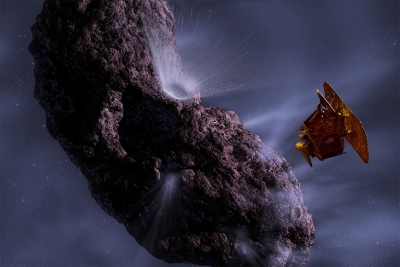
Comets have been observed by humanity and recorded in human history for ages. Celestial objects consisting of a nucleus of ice and dust and, when near the sun, a tail of dust and gas particles pointing away from the sun, comets were embroiled in superstition until they were studied from a scientific viewpoint in the last few centuries.
It was only in this millennia that we developed enough know-how to target one such comet and deploy an impact probe towards it. The resulting collision, the first such planned event, enabled us to rethink our understanding of the formation of comets and how they work.
Unlike previous NASA flyby missions, the Deep Impact was from the start intended to study the internal composition of a comet. It consisted of two parts: a coffee table-sized main flyby spacecraft that weighed a little over 600 kg and a smaller probe that weighed 372 kg and designed for the impact.
Unique payload
Fitted with some of the latest instruments and cameras, the Deep Impact also had an unusual payload. This was a compact disc as part of a campaign to send names to a comet and held within it the names of 6, 25,000 people.
Following its launch on January 12, 2005, Deep Impact was put in a low-Earth orbit, then an elliptical orbit before it headed on an Earth escape trajectory. Nearly six months and 429 million km later, Deep Impact reached Comet 9P/ Tempel 1.
Bang on target
On July 3, 2005, the impact or probe was released by Deep Impact to move into the path of the comet. As per plan, on July 4, 2005 (American Independence Day), the probe, which was travelling at a relative velocity of 37,000 km/hr at the time of impact, crashed into Tempel 1. The collision created an explosion the equivalent of 4.26 tonnes of TNT and a crater that was about 150 m in diameter.
Minutes later, the flyby spacecraft passed close-by, clicking images of the crater, ejecta plume and the entire nucleus. Ground-based and space-based observatories also collected information, both about the impact and its results, in a coordinated effort.
Based on these results, scientists were able to conclude that Comet Tempel 1 had probably originated in the Oort Cloud – the most distant region of our solar system. The data also showed that the comet was rather fluffy, with nearly 50% of the nucleus and 75% of the surface shell (the comet as a whole) comprising empty space.
EPOXI mission
Even though Deep Impact’s primary mission was over, it had enough propellant left to get a supplementary mission. This mission came to be known as EPOXI, derived by combining the two components of this mission, Extrasolar Planet Observation and Characterisation (EPOCh) and Deep Impact Extended Investigation (DIXI).
After Deep Impact’s new target, Comet 85P/Boethin, was lost as it probably broke up, it was redirected to Comet 103P/ Hartley 2. This flyby was achieved in November 2010 and the data collected showed that the two lobes of Hartley 2 were different in composition.
Before getting to Hartley 2, Deep Impact had to perform three Earth flybys over two years. Ahead of the second flyby, it performed the EPOCh mission, investigating extrasolar planet around eight distant stars using its instruments.
Works with Chandrayaan-1
It also utilized this time to better study our Earth, which included collecting enough detail to find out what a habitable world looks like. Along with India’s Chandrayaan-1 and NASA’s Cassini space probe, Deep Impact was also able to reveal the first clear evidence of water on the surface of the moon.
A third target for flyby in 2020 was identified for Deep Impact and the spacecraft was used for remote study of faraway comet in the meantime, but NASA lost touch with it in August 2013. Despite considerable repeated efforts to contact the spacecraft, NASA officially abandoned efforts to contact Deep Impact on September 20, 2013.
In its operational period of over eight years, Deep Impact produced way more data than had been planned and enhanced our understanding, especially about comets.
Picture Credit : Google




